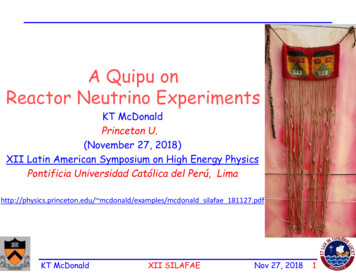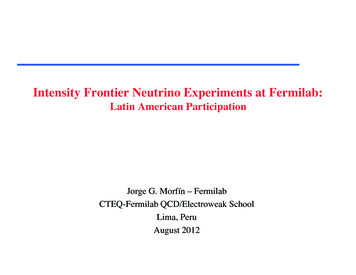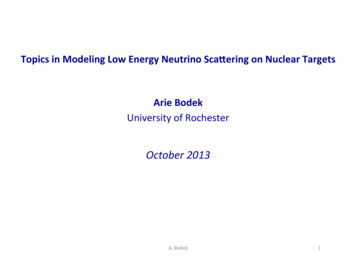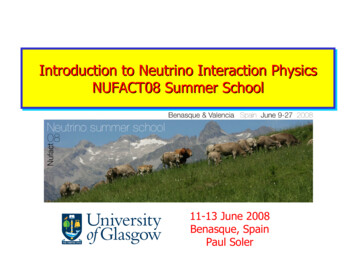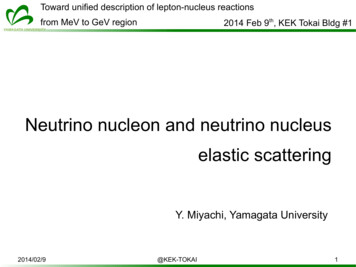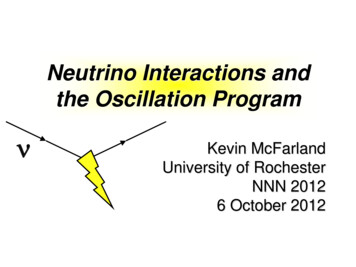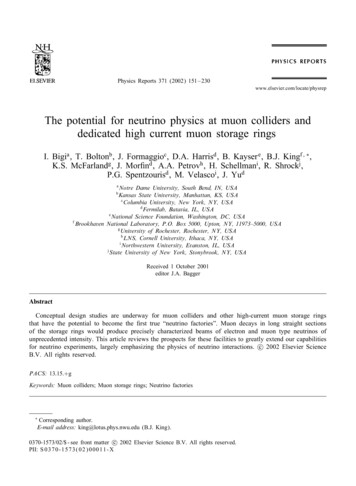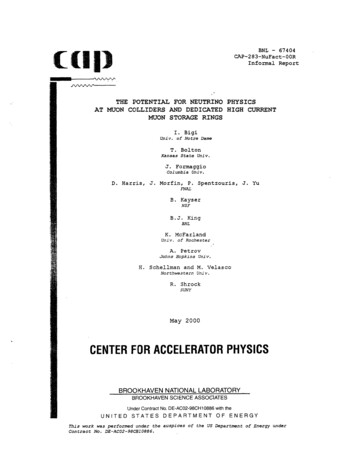
Transcription
BNL - 67404CAP-283-NuFact-OORInformal ReportTHE E'OTENTIAL FOR NEUTRINOAT MUON COLLIDERS AND DEDICATEDMUON STORAGE RINGSPHYSICSHIGH CURRENTI. BigiUniv. o.fNotre DameT. BoltonKansas State Univ.J. FormaggioColumbia Univ.D. Harris,J. Morfin, P. Spentzouris,MALJ. YuB. KayserNSFB.J.KingBNLK. McFarlandUniv. of RochesterA.PetrovJohns Hc'pkins Univ.H. Schellmanand M. VelascoNorthwestern Univ.R. :Shrock:XJNYMay2000CENTER FiORACCELERATORPHYSICSBROOKHAVENNATIONAL LABORATORYBFlOOKHAVENSCIENCE ASSOCIATESUnder Contract No. DE-AC02-98CH10886UNITEDSTATESDEPARTMENTwith theOFENERGYThis work was performed under the auspices of the US Department of Energy underContract No. DE-AC02-98CB10886.
DISCLAIMERThis report was prepared as an account of wwrk sponsored by an agency of the UnitedStates Government. Neither the United States Government nor any agency thereof,nor any of their employees, nor any of their contractors,subcontractors,or theiremployees, makes any warranty, express or implied, or assumes any legal liability orresponsibilityfor the accuracy,completeness,or usefulness of any information,apparatus, product, or process disclosed, or represents that its use would not infringeprivately owned rights. Reference herein to any specific commercial product, process,or service by trade name, trademark, manufacturer, or otherwise, does not necessarilyconstitute or imply its endorsement, recommendation,or favoring by the United StatesGovernmentor any agency, contractoror subcontractorthereof. The views andopinions of authors expressed herein do not necessarily state or reflect those of theUnited States Government or any agency, contractor or subcontractor thereof.
The Potential for Neutrino Physicsat Muon Colliders and Dedicated High CurrentMuon Storage RingsAuthors:IkarosBigi (U. Notre Dame), Tim Bolton (Kansas State U.), Joseph Formaggio (Columbia U.), Debbie Harris (FNAL), Boris Kayser (NSF), Bruce King 1(BNL), Kevin McFarland (U. Rochester), Jorge Morfin (FNAL), Alexey Petrov(Johns Hopkins U.), Heidi Schellman (Northwestern U.), Robert Shrock (StonyBrook U.), Panagiotis Spenteouris (FNAL), Mayda Velasco (Northwestern U.),Jaehoon Yu (FNAL).Abstract:Conceptual design studies are underway for both muon colliders and highcurrent non-colliding muon storage rings that have the potential to become thefirst true “neutrino factories*. Muon decays in long straight sections of thestorage rings would produce uniquely intense and precisely characterized twocomponent neutrino beams -. muon neutrinos plus electron antineutrinos fromnegative muon decays and electron neutrinos plus muon antineutrinos from positive muons. This article presents a long-term overview of the prospects for thesefacilities to greatly extend our capabilities for accelerator-based neutrino physicsstudies for both high rate and long baseline neutrino experiments. As the firstmajor physics topic, recent experimental result.s involving neutrino oscillationshave motivated a vigorous design effort towards dedicated neutrino factoriesthat would store muon beams of energies 50 GeV or below. These facilitieshold the promise of neutrino oscillation experiments with baselines up to intercontinental distances and utilizing well understood beams that contain, for thefirst time, a substantial component of multi-GeV electron-flavored neutrinos. Indeference to the active and S&-moving nature of neutrino oscillation studies,the discussion of long baseline physics at neutrino factories has been limited toa concise general overview of the relevant theory, detector technologies, beamproperties, experimental goaks and potential physics capabilities. The remainderof the article is devoted to the complementary high rate neutrino experimentsthat would study neutrino-nucleon and neutrino-electron scattering and wouldbe performed at high performance detectors placed as close as is practical tothe neutrino production straight section of muon storage rings in order to exploit beams with transverse dimensions as small as a few tens of centimeters.Icontact author, email: bkingQ!bnl.gov .1
We discuss the potential for three types of novel neutrino targets and detectorsthat, if realizable, could together usher in a new era of high precision neutrinophysics studies: 1) fully-active vertexing and tracking targets surrounded byhermetic backing detectors that would potentially reconstruct at least of order 10’ events per year per kilogram mass, 2) cryogenic polarized targets thatshould allow the first studies of spin physics with neutrino beams, and 3) fullyactive tracking liquid targets with masses of several tons for reconstructing therarer neutrinoelectronscattering events. The diverse areas of high rate neutrinophysics considered in this article include: (i) the only known opportunity in anyphysics process to map out the detailed quark-by-quark Pmomentum and spinsubstructure of the nucleon, (ii) two precision tests of the weak mixing angle thatcharacterizes the electroweak interaction, sin2 &,I, from both neutrino-electronscattering and deep inelastic neutrino-nucleon scattering, perhaps to an accuracy at the 10m3 to 10e4 level (iii) the most precise measurements of the CKMmatrix elements lVcdj and IV,I, (iv) additionally, beam energies well above the25 GeV production threshold for b quark production might also yield uniquelyprecise measurements of the much more theoretically interesting elements /V&land IV&l, perhaps at the l-3% level of precision, (v) several searches for rare andexotic processes, and finally, (vi) samples of hundreds of millions of preciselyreconstructed charm decays would allow additional analyses outside neutrinophysics. The expected experimental conditions at neutrino factories are so superior to today’s neutrino experiments that the contents of this article mustsurely represent no more than a limited fhst attempt at understanding theirfull potential for neutrino physics.2.v
.22.32.42.52.62.72.82.92.10and Physics13Overview.Introduction.1.1.1 High Current Muon Storage Rings and their Use for Neutrino Physics .1.1.2 The Potenti#al Role of vMCs in High Energy Physics .1.1.3 Some Preliminaries on Layout and Notation .Experimental Overview .1.2.1 A Primer on the Deep Inelastic Scattering Interactions ofNeutrinos .1.2.2 Neutrino Beam Characteristics and Event Rate Parameters at Long Baseline and High Rate Detectors .1.2.3 Neutrino Detectors for vMCs .Physics Analysis Topics .1.3.1 Neutrino Os.cillations .1.3.2 QCD and Deep Inelastic Scattering .1.3.3 The CKM Quark Mixing Matrix .1.3.4 Precision Electroweak Physics .1.3.5 Rare and Exotic Processes .1.3.6 Charm Decays .OscillationExperimentswith a Muon1314141515172124242627272929Storage Ring/Neutrino31Evidence for Neutrino Oscillations .Neutrino Oscillation Formalism .Types of Neutrino Masses, Seesaw Mechanism .Tests for Neutrino Masses in Decays .Models for Neutrino Masses and Mixing .Lepton Mixing .Near Term Future ExperimentsOscillation Experiments at a Neutrino Factory .Matter Effects .Detector Considerations .2.10.1 Magnetized Sampling Calorimeter .2.10.2 Liquid Argon TPC .313313234393941434446464748
34548482.10.3 Muon Detector Conclusions .2.10.4 Tau and Electron Detectors .2.11 Conclusions .49Deep Inelastic Scattering and QCD Studies3.1 Introduction. .3.2 Deep Inelastic Scattering. .-3.2.1 Kinematics of unpolarized DIS .3.2.2 Kinematics of polarized DIS .3.3 Measurements of ay8 .3.4 Measurement. of Quark Densities .3.5 Polarized Parton Densities and Spin Structure of Nucleon3.6 Studying Nuclear Effects with Neutrinos .3.6.1 Low z: PCAC and Nuclear Shadowing .3.6.2 Mid x: Anti-shadowing and the EMC Effect .3.6.3 High x: Multi-quark Cluster Effects .3.7 Higher Twist .3.8 J/ Production and Gluon Distribution Functions .3.9 AZ Form Factors .515151525354555863646666666870.Studies of the CKM Quark MiigMatrix4.1 Introduction. . . . . . . . . . . . . . . . . . . . . . . . . . .4.1.1 Currentexperimentalknowledgeof the CKM matrix andfuture expectations before vMCs . . . . . . . . . . . . . .4.1.2 Extracting CKM matrix elements in VMCS : an overview4.2 Analyses involving charm production: extraction of Vcd and V,, .4.3 Analyses involving bottom production: extraction of & and V&4.4 v&&& via Diffractive Charmed Vector Meson Production . . . .4.5 Improvement of CKM knowledge from VMCS . . . . . . . . . . .7373Precision Electroweak Studies5.1 Introduction. .5.1.1 Knowledgeat the time of YMC .5.1.2 Goals of a fixed-target electroweak physics programs .5.1.3 Electroweak processes with neutrinos .5.2 Elastic and Quasi-Elastic Neutrin Electron scattering .5.2.1 Current Measurements .5.2.2 Experimental Concerns .5.2.3 Detector considerations for neutrino-electron elastic scattering .5.2.4 Estimates of Sensitivity .5.3 sin28w from DIS .5.3.1 Previous Measurements .5.3.2 Experimental Technique .5.3.3 Theoretical Issues .5.3.4 Improvement in sin2 0 Measurement .8181818282838688474757677787889909090919597
5.45.3.5 Outlook and Comparisons of sin28w Measurements . . .Summary and Co:nclusions . . . . . . . . . . . . . . . . . .97986Rare and Exotic Processes6.1 Introduction .6.2 Studies of Low Energy QCD .6.2.1 Gee- Annihilation .6.2.2 W*/Z*-photon Scattering .6.3 New Physics Sensitivity .6.3.1 Flavor Changing Neutral Currents .6.3.2 Generic Four-Fermion Operators .6.3.3 Heavy Neutral Lepton Mixing .6.4 Conclusion .1011011011011031041041061071107Heavy Flavor Physics7.1 Introduction. .7.2 Theoretical Motivation for Charm Physics .7.3 Probing Strong Interactions througlh Charm Decays7.3.1 Absolute Charm Branching Batios .7.3.2 D,, D - p v, r u .7.3.3 Inclusive Charm Hadron Delcays .7.4 Searches for New Physics in Charm Decays .7.4.1 Do - b” Oscillations .7.4.2 CP Violation in D Decays .7.4.3 T Odd Correlations in A, D’ecays .7.5 B Physics .7.6 Summary ryA Neutrino Beams at ‘Muon CollidersA.1 Neutrino Spectra, Beam Intensities and Event Hates at Experiments . . . . . . . . . . . . . . . . . . . . . . . . . . . . . . . .A.l.lOverview of neutrino beam Icharacteristics . . . . . . . .A.2 Calculations of the Neutrino Beam Parameters . . . . . . . . .A.2.1 Calculations of the Neutrino Energy Spectra . . . . . .A.2.2 calculations for short baseline detectors . . . . . . . . .A.2.3 calculations for long baseline detectors . . . . . . . . . .A.3 Design Options for Neutrino Production . . . . . . . . . . . . .A.3.1 Neutrino beams from recirculating linacs . . . . . . . . .A.3.2 Neutrino beams from long straight sections in a muoncollider ring . . . . . . . . . . . . . . . . . . . . . . . . .A.3.3 Neutrino beams from dedicated muon storage rings . . .A.4 Neutrino radiation constraints . . . . . . . . . . . . . . . . . . .A.5 MC Scenarios Used for the Calculation of Neutrino Event Hates5127.127127128129130132133133. 133. 134. 135136
BA GeneralB.lB.2B.3PurposeDetectorfor DIS NeutrinoInteractions139Detector Overview . . . . . . . . . . . . . . . . . . . . . . . . 139CCD target . . . . . . . . . . . . . . . . . . . . . . . . . . . . . . 140Detector surrounding the target . . . . . . . . . . . . . . . . . . . 141Bibliography143
List of Talbles1.1Average neutrino energies and rms energy spreads as fractions ofthe maximum neutrino energy at any chosen polar angle relativeto the neutrino beam axis. The “beam” row gives the fraction forthe neutrino beam itself while the “events” column is weightedby the energy-dependent neutrino cross-section. (See the text fordetails.) . . . . . . . . . . . . . . . . . . . . . . . . . . . .181.2Neutrino fluxes and event rates for example parameter sets formuon storage rings (muSR’s) or muon colliders. . . . . . . . .211.3Specifications, integrated luminosities and event rates for the HRtargets discussed in. this paper and for 50 GeV (500 GeV) muonstorage rings. The approximation is made that the target is situated 100 m (1 km) downstream from a straight section that hasZVis 10zo decays of 50 GeV (500 GeV) muons and that its radialextent subtends an angle of I/r at the production straight settion. The beam energy corresponds to average neutrino energiesof 32.5 GeV (325 G’eV) and to approximately l(2) years runningfor storage ring parameters given previously in the literature. . .261.4Absolute squares of the elements in the Cabbibo-Kobayashi-Maskawa(CKM) quark mixing matrix. The second row for each quarkgives current [lo] percentage l-sigma uncertainties in the absolute squares and speculative projections of the uncertainties afteranalyses from a vMC operating with neutrino energies well abovethe B production threshold. The measurements of ]V,d12 andIV, I2 might be comparably good for a 50 GeV vMC but ]VUb12and ]Vct,12would not be measured. The uncertainties assumethat no unitarity constraints have been used. . . . . . . . . . . 283.1Total cross sections for the J/l/l production in UN J/ X forvarious representative incident neutrino energies. . . . . . . . . .70gr, and gR by Y - e scattering process listed for the cross-sectionformula in Eqn. 5.7. The numerical values in the final columncorrespond to the combination of couplings that appears in thetree-level total cross-section for sin2 61 0.23. . . . . . . .855.17
5.2Expected sin28w uncertainties in vMC beam, compared to NuTeVpreliminary result. . . . . . . . . . . . . . . . . . . . . . . . . .926.1Threshold neutrino energy for various hadronic final states.A.1Contributions to the cross section from the different types of neutrino interactions. The reduced cross-section and product are inunits of 10-35cm2/TeV.Their numerical values, summed overCC and NC interactions, are given in reference [7] with ok specified for 100 GeV neutrinos on an isoscalar target. . . . . . . . . 132B.lB.2. . . 102Tagging efficiencies for charm and beauty tags. . . . . . . . . . . 141Approximate values for the uncertainties in some of the important resolution parameters of the high rate neutrino detector.The symbol “@ denotes addition in quadrature and the dimensioned quantities are to be evaluated in the units given in squarebrackets. It is assumed that charged tracks have length LccD inthe CCD’s, determined by the vertex position and the distanceto either interacting or exiting out the side of the CCD. Since theneutrino target is at the upstream end of the TPC, the assumedlength, LTPC,in the TPC will typically be close to the 5 meterIenethoftheTPC. . . . . . . . . . . . . . . . . . . . . . . . 142.
.List of Figures1.11.21.32.13.13.2Neutrino event spectra (weighted by the interaction cross section)for muons neutrinos and electron anti-neutrinos from a negativemuon beam. The solid curves indicate the spectra for decays atzero degrees in the center of mass sy,stem. This is the spectrumexpected for a detector located very far from the muon decayregion. The dashed curves indicate the spectra for decays withinthe forward hemisphere in the center d mass frame. This is whatwould be expected for a detector close enough to the muon decayregion to subtend an angle of . . . . . . . . . . . . . . . . . . .19Plots for the fractional production of charm and beauty for neutrinos and anti-neutrinos scattering off nucleons. Fractional production is plotted versus neutrino energy and the calculationswere performed at leading order. . . . . . . . . . . . . . . . . . .23Example of a general purpose neutrino detector, reproduced fromreference [4]. Its scale is illustrated by a human figure in the lowerleft comer. The neutrino target is the small horizontal cylinder atmid-height on the right hand side of th.e detector. Its radial extentcorresponds roughly to the radial spread of the neutrino pencilbeam, which is incident from the right hand side. The illustrationis partially schematic in that the geometries of the calorimetersand dipole magnet have been simplified for illustrative purposes,asdiscussedfiutherinthetext. . . . . . . . . . . . . . . . . .25v, and ijU event rattes per GeV as #afunction of E/L for twodifferent experiments, and the L/E dependence of the oscillationprobability, assuming the largest bm* is 2,3.5,or 5 x 10m3GeV2. .50Model dependent decomposition of singlet term into quarks andgluon based on PDIS data, a0 Aq - 3eAg.Also shown arethe QPM expectation and the results from a NLO fit to most ofthe available data on 9: . . . . . . . . . . . . . . . . . . . . . . .61&6:& for both Fz and xFs as measured in a 2 year exposure atthe facility described in the text. . . . . . . . . . . . . . . . . . .659
3.3The contributions of the various matrix elements as a functionof Q2 for FMC-Ring, with baseline-sized matrix elements. Observe that the contributing linear combination of matrix elementsdrastically changes with Q2 within a region where the rate is stillsizable, so one can realistically extract both the 3S,(8) and the5.15.25.35.45.55.65.76.13Py’ matrix elements even without requiring exceedingly highstatistics. . . . . . . . . . . . . . . . . . . . . . . . . . . . . . . .72Feynman diagrams for the Y - e scattering processes expected inneutrino beams from a muon collider: (a) NC u-e scattering, (b)CC v,-e scattering, (c) CC K-e annihilation, (d) inverse muondecay. . . . . . . . . . . . . . . . . . . . . . . . . . . . . . . . . .84Integral cross-section for neutrino-electron scattering processesabove y gcut, and assuming E,, 30 GeV. . . . . . . . . . . .85Change in the integral cross-section with respect to sin2 8 forneutrino-electron scattering processes above y Ycut, assumingE, 30GeV. . . . . . . . . . . . . . . . . . . . . . . . . . . .86Statistical uncertainty in sin2 8 for an integrated luminosity of1046cm-2 by process above y pcut, assuming E, 30 GeV.The statistical uncertainty in a given experiment is proportionalto the inverse square root of the average energy. . . . . . . . . . .87Statistical uncertainty in sin2 0 for an integrated luminosity of1046cm-2 by process above y vcut assuming beams with equalneutrino and anti-neutrino fluxes and E, 30 GeV. . . . . . . .87Monte-Carlo generated picture of a high energy neutrino-electronscattering interaction in liquid helium. (Note the distorted scalethat is indicated by the relative lengths of the x and z axes.) Theview is perpendicular to both the beam direction and a 0.1 Teslamagnetic field. . . . . . . . . . . . . . . . . . . . . . . . . . . . .89Expected uncertainties of TeV 33 and uMC Mw vs MT in theyear2010. . . . . . . . . . . . . . . . . . . . . . . . . . . . . . . .99Plots for jiYB 12, IUe 12, and IUp iYe l limits as a function ofLO mass for one year of running. The solid, dashed, and dottedlines represent muon collider energies of 10, 20, and 250 GeVrespectively. The plots on the left show limits for L 12 m, andthe plots on the right show limits for L 1 km . . . . . . . . . . 10910.
7.1Conceptual illustration of the vertex,tagging superiority at vMCs overthat with collider experiment geometries. (Figure reproducedfrom reference [9].) Neutrino targets such as those discussed inappendix B would have a vertex plane of CCD pixel detectorsspaced at intervals of approximately one millimeter. For comparison, the VXD3 vertexing detector at the SLD [81] experiment,which is universally regarded as the best existing vertex detector in atollider experiment, has its two innermost CCD trackingplanes at 2.8 cm and 3.8 cm from the interaction point (IP). Acartoon of a l-prong D decay has been drawn to illustrate theadvantages of closely spaced vertex detectors. For clarity of illustration, the kink deflection angle has been drawn much largerthan would be typical. The 2 cm distance to decay for the Dfcharmed meson corresponds to the average boosted lifetime for a120 GeV D . . . . . . . . . . . . . . . . . . . . . . . . . . . . . . 11311
.
Chapter 1.Int reduction and PhysicsOverview1.1Introduction1.1.1 High Current Muon Storage Rings and their Use forNeutrino PhysicsMuon colliders, storage rings in which muons are collided instead of electrons orprotons, have been proposed as a means of cirwmventing the natural limitationson electron-positron storage rings due to synchrotron radiation. Synchrotronradiation by a muon beam is reduced by a factor of (%)” z 5 x 10-l’ relativeto a circulating electron beam of the same energy, Recent feasibility and designstudies for future muon colliders [l, 21 have begun to focus attention on theexciting possibilities for physics experiments using the neutrino beams fromhigh energy muon decays.The proposals to use the neutrino beams emanating from straight sectionsin the magnet lattices of either muon colliders [3, 41 or muon storage rings designed specifically for neutrino physics [5] (dedicated “neutrino factories’) arereincarnations of suggestions for neutrino experiments at muon storage ringsthat date back at least to tlhe 1960’s. The essential difference is the very largemuon currents that might be produced and stored using muon collider technology [I, 21.The resulting neutrino beams may be many orders of magnitude moreintense than considered in the early references and, indeed, considerably moreintense than today’s “conventional” neutrino beams from pion decays. Additional physics advantages will result from their unique and precisely understood decays will produce pure 2-component neutrinoflux composition: p- and LCbeams containing (z iT,) or (F,,ve), respectively.This book explores the physics potential for these “neutrino experiments at13
muon colliders”, or yMCs for short, where this is implicitly includes the optionof non-colliding muon storage rings dedicated to the production of neutrinobeams.The reader is referred to the specialist literature [l, 21 for the detailed technologies required for muon colliders and storage rings. These will be discussedonly to the extent that they determine the properties of the neutrino beams.As a caveat on the physics potential of high intensity muon storage rings, itshould always be borne in mind that the ambitious technologies of muon storage rings are still only at the level of either feasibility studies or early designstudies and, at present, it is still not guaranteed that they will progress throughto realization.1.1.2The Potential Role of VMCS in High Energy PhysicsNeutrinos are theoretically interesting because they are either massless or nearlyso, with growing indirect evidence from neutrino oscillation experiments formasses of the order of eV or less, which is at least several orders of magnitudebelow the masses of their charged lepton partners.The interactions of neutrinos are also worthy of study, both in their ownright and as probes of the quark content and dynamics of nucleons. Severalprecise measurements involving the electroweak and strong interactions augmentthose from electron-positron colliders as a testing-ground for the consistencyof the Standard Model of elementary particle physics and of Standard Modelcalculations using perturbative field theory. As well as looking for hints of newphysics, the consistency of Standard Model calculations must be establishedin order to interpret the data from high energy colliders and to distinguishbackground processes from possible signatures for new physics.In combination therefore, muon storage rings have wide-ranging potential tomake advances in many areas of elementary particle physics, both in precisiontests of the Standard Model and in searches for evidence of new physics beyondthe Standard Model.1.1.3Some Preliminaries on Layout and NotationThe currently volatile status of neutrino oscillation measurements makes it dishcult to assess the potential for neutrino oscillation experiments at muon storagerings. Additionally, this topic has already been covered in some detail elsewhere [S]. Therefore, only one chapter, chapter 2, is devoted to long baselineoscillation experiments, despite the current interest in this topic and the impressive potential for studies at dedicated neutrino factories or muon colliders.Instead, this book concentrates largely on the high-rate neutrino physics possibilities at detectors close to the muon straight section. Chapters 3 through 7discuss each of the main classes of physics at vMCs ; in order: deep inelasticscattering and QCD studies, the CKM mixing matrix, precision electroweakstudies, rare and exotic processes and charm physics.14
The concept of neutrino experiments at high current muon storage rings isnovel enough that the notal;ions to describe these facilities are not yet settled. Asalready mentioned, this book will refer to them as ‘%MCs “, short for “neutrinoexperiments at muon colliders”, with the implicit understanding that the termalso covers experiments at “dedicated” neutrino factories. It is noted that thealternative name “MUR.INEs”, standing for MUon Ring Neutrino Experiments,is also in use. Another convention and abbreviation in use in this book will be torefer to neutrino oscillation experiments as “long baseline” or LB experimentsand the complementary experiments that study neutrino interactions will bereferred to as either high rate (HR) or short baseline (SB) experiments. As onefinal notational note, units are given in square brackets in equations throughoutthe book.1.2Experimental OverviewThe experimental requirements will be rather different for the two broad classesof neutrino physics, i.e., studies of neutrino oscillations and of neutrino interactions. Neutrino oscillations will usually be studied at long baseline experimentswhile the other topics will be investigated through studies of neutrino-nucleondeep inelastic scattering (DIS) and neutrinocelectron elastic scattering. Thesewill be conducted at short baselines to maximize the event rates.This section is split into three subsections. The first subsection gives a primeron the dominant interaction process of many&Vneutrino, namely, neutrinenucleon deep inelastic scattering (DIS). The middle subsection then discussesthe characteristics of the neutrino beams for vMCs and also takes advantageof the cross section infomlation from the preceding subsection to define andquantify some parameters that will characterize the event rates at high rate andlong baseline detectors. The detailed calculations for this subsection have beenrelegated to an appendix, appendix A. This subsection culminates with a tableof predicted beam parameters and event r,ate parameters for some examplemuon storage ring parameters. Again, the justifications for the storage ringparameters have been relegated to appendix A. The section is rounded outwith a subsection that discusses SB and LB detector design considerations andscenarios. Detector scenarios are combined with the tabulated information fromthe preceding subsection to predict order-of-magnitude event sample sizes forboth short and long baseline experiments.1.2.1A Primer on the Deep Inelastic Scattering Interactions of NeutrinosThe dominant interaction of TeV-scale neutrinos is deep inelastic scattering(DIS) off nucleons (i.e. protons and neutrons), of which there are 2 types:neutral current (NC) and charged current (CC) scattering.NC scattering comprises about 25 percent of the total interaction cross section. The neutrino is deflected by a nucleon (N) and loses energy with the15
production of several hadrons (X):Y N ,u X.(1.1)For neutrino energies beyond a few GeV, DIS becomes rather well describedby the quark-parton model. In this model, NC DIS is interpreted as elasticscattering off one of the many quarks inside the nucleon through the exchangeof a virtual neutral Z boson:v q v q.(l-2)CC scattering is similar to NC scattering except that the neutrino turns intoits corresponding charged lepton:u N Z- X,i7 N l X,(1.3)where I is an electron/muon for electron/muon neutrinos. In the quark-pa&onmodel this is interpreted as an exchange of a W boson between the neutrinoand a quark (q), which is turned into another quark species (q’) whose chargediffers by one unit.v q z- q’,F’ q’ z q.0.4)For NC and CC interactions alike, the final state quark always “hadronizes”at the nuclear distance scale, combining with quark-antiquark pairs to producethe several primary hadrons, X, that are seen in the detector.The quark-parton model is a useful approximation to neutrinonucleon DISthat will be used extensively throughout this book to describe the potentialphysics analyses at vMCs . However, it should be noted that the actual analyses would be performed using more correct and detailed descriptions of theinteractions for which the qu
The Potential for Neutrino Physics at Muon Colliders and Dedicated High Current Muon Storage Rings Authors: Ikaros Bigi (U. Notre Dame), Tim Bolton (Kansas State U.), Joseph Formag- gio (Columbia U.
